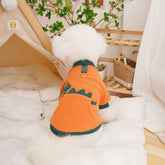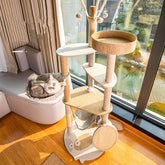Understanding Your Cat's Emotional Needs: Signs of Feline Attachment
Table of Contents
- Key Highlights:
- Introduction
- Your Cat Follows You Everywhere
- Vocalizing for Your Attention
- Seeking Physical Contact and Cuddles
- Displaying Separation Anxiety
- Bringing You “Gifts” and Sharing Their World
- Mirroring Your Emotions and Behavior
- Initiating Eye Contact and “Slow Blinks”
- Choosing You Over Other People or Pets
Key Highlights:
- Cats form deep emotional connections with their owners, demonstrating affection and dependence in various ways.
- Key signs of a cat’s emotional reliance include following their owner everywhere, vocalizing for attention, and seeking physical contact.
- Understanding your cat’s behavior can foster a stronger bond and enhance both your lives.
Introduction
While cats are often characterized as independent beings who thrive in solitude, the reality is quite different. Beneath their seemingly aloof exteriors lies a capacity for deep emotional relationships with their humans. Many cat owners may find themselves taken aback by the realization that their feline companions rely on them not only for sustenance but for comfort, reassurance, and love. Observing a cat's subtle cues can reveal a heartwarming narrative of emotional dependence that goes far beyond mere companionship.
Understanding these behaviors not only fosters a deeper bond between cat and owner but can also provide insights into feline psychology and contribute positively to their overall well-being. In this article, we will delve into the various signs that indicate your cat may be emotionally attached to you, revealing how these affectionate gestures reflect their dependence and trust.
Your Cat Follows You Everywhere
One of the most striking behaviors that showcases your cat's emotional attachment is their tendency to shadow you at every turn. If your feline companion seems to follow you from room to room, this behavior may signal a need for security and comfort. Cats that feel safe with their humans often exhibit this trait, positioning themselves close to their owners even in mundane activities like cooking or cleaning.
This constant presence is more than curiosity—it's a clear indicator of reliance. It's during moments of uncertainty or stress when many cats seek out their owner's presence, curling up next to them or waiting patiently outside the bathroom door. Such behaviors highlight the emotional assurance that your cat derives from being near you, illustrating the depth of their affection and trust.
Consider the story of a cat named Oliver, who developed a routine of following his owner, Lisa, everywhere after she adopted him from a shelter. Oliver would sit outside the bathroom door while Lisa prepared for her day, and curl up in her lap as she worked. His following behavior was not simply boredom; it reflected a profound sense of emotional connection, offering Lisa comfort in knowing he felt safe with her.
Vocalizing for Your Attention
Cats communicate in various ways, and one of the most telling signs of their emotional dependence is through vocalization. While some cats are naturally more vocal than others, consistent meowing, trilling, or chirping when near their owners typically indicates a desire for attention and connection. Engaging with your feline each time they vocalize is essential; it reinforces the bond you share and shows your attunement to their needs.
The nuances in a cat's vocalizations can often tell a story. For instance, softer meows might indicate contentment or a request for affection, while louder cries could convey anxiety or a need for reassurance. This communication reflects a cat's attachment and signifies their emotional reliance on you as a source of stability and love.
One notable example is Mia, a chatty Siamese, who often meows at her owner, Sarah, upon entering the room. These vocalizations are not merely demands for food; they are calls for interaction and a longing for emotional closeness. Sarah has learned to respond with gentle words and playful engagement, fostering an enriching dialogue that strengthens their bond.
Seeking Physical Contact and Cuddles
Physical proximity often marks a cat's expression of emotional dependence. Cats that seek out physical contact typically rely on their owners for comfort, safety, and emotional well-being. Whether it’s draping themselves over you while you work, curling up in your lap during movie nights, or following you into bed, these gestures signify a deep trust.
During moments of distress, such as thunderstorms or loud noises, many cats instinctively seek out their owners. This behavior reveals not just a desire for warmth but an acknowledgment of their emotional anchor. The act of touch becomes their primary mode of expressing vulnerability, and by offering comfort to your cat during such moments, you contribute to a stronger emotional foundation in your relationship.
Another case is that of Felix, who would always snuggle up close to his owner during storms. Whenever thunder rumbled, he would rush over to find solace in her embrace, fully demonstrating his reliance on her for emotional support. This shared experience not only reassured Felix but also deepened the bond between him and his owner.
Displaying Separation Anxiety
Despite their independent reputations, cats can experience separation anxiety when left alone. Emotional reliance on their owners can manifest in various behaviors indicating distress in their absence, such as excessive vocalizations, refusal to eat, or destructive tendencies.
Cats who display anxiety when their humans leave the house frequently wait by the door and greet their owners with fervent affection upon return. Such behaviors are heartwarming yet pitiful, painting a poignant picture of a cat longing for companionship. This emotional connection is especially pronounced in cats that have endured significant trauma or irregularity in their environment.
For instance, Luna, a rescuer who had been separated from her previous owner before finding a new home, showed signs of separation anxiety when her owner left. She would pace and meow incessantly, only to calm down significantly when her owner was back. Understanding this behavior enabled her owner to implement strategies to ease Luna's anxiety through gradual departures and positive reinforcement.
Bringing You “Gifts” and Sharing Their World
When cats bring you “gifts,” such as toys or even small prey, it’s an expression of their individual affection. While some might view these gestures as simply showing off hunting prowess, they reflect a deeper emotional connection. This behavior is a unique way for cats to express trust and a desire to nurture their owners, showcasing their emotional reliance.
These “gifts”—whether a favorite toy or a peculiar object from the household—indicate that your cat regards you as part of their family unit. Some cats even bring comforting items, such as a blanket or a cherished piece of your clothing, and place them close to you. This sharing behavior is not just about the object itself but embodies a heartfelt connection.
An amusing instance involved a ginger cat named Jasper who would frequently present his owner, Tom, with an assortment of odd items from around the house—everything from socks to his favorite feather toy. Jasper’s offerings were not merely entertainment; they were displays of love and an invitation to strengthen their bond.
Mirroring Your Emotions and Behavior
Felines possess a remarkable sensitivity to human emotions, often reflecting the feelings of those around them. Cats may act calm when their owners are relaxed or become agitated when their owners are upset, showcasing a fascinating instinct for emotional attunement. This mirroring behavior signifies their emotional connection, demonstrating that they are not just passive observers in your life.
A cat attuned to your emotional state can become a source of comfort during challenging times. You might find that your cat curls closer to you during periods of sorrow or offers companionship during moments of stress, silently providing support. This synchronous emotional exchange deepens your connection and nurtures a shared understanding.
One relatable case involves Bella, a gentle tabby who would approach her owner whenever she sensed distress. Following a long day, Jennifer would often find Bella by her side, purring softly, mirroring her mood while offering warmth and support. Their shared experiences not only reinforced Bella's dependence but also made her owner feel less alone.
Initiating Eye Contact and “Slow Blinks”
An intimate gesture often overlooked is the “slow blink,” a sign of trust in cats. When a cat gazes at you and gradually closes its eyes, it symbolizes a deep emotional connection. In cat communication, direct eye contact is usually reserved for those they feel most secure with. When your cat initiates this special eye contact, they give you an affectionate message about their feelings.
Reciprocating the slow blink can strengthen the bond between you and your feline. This simple act fosters mutual trust, enhancing emotional reliance and making your cat feel safe and cherished.
A story highlighting this behavior features a cat named Whiskers, who would often gaze intently at his owner, Lily. When she responded with slow blinks of her own, it created a comforting ritual that solidified their emotional connection, making their moments together all the more special.
Choosing You Over Other People or Pets
Cats are known for their selective affection, and if your cat consistently chooses to spend time with you over other people or pets, it’s a compelling sign of emotional reliance. This behavioral trait highlights the unique bond you’ve formed, suggesting that your cat feels safest and most comfortable by your side.
Observing your feline ignoring visitors or other pets in favor of seeking your company illustrates the significance of your relationship. It’s an honor to be chosen as their primary source of emotional support, revealing a deep trust that has blossomed over time.
Take the example of Snowball, a fluffy Maine Coon who would always ignore guests in favor of curling up on his owner’s lap. His exclusive attention toward his owner during stressful occasions exemplified the profound connection they shared, reinforcing their emotional bond and the trust he placed in her.
FAQ
Q: Do all cats show emotional dependence? A: Not all cats display overt signs of emotional dependence, as personality varies from one animal to another. However, many cats possess the capacity for deep emotional connections, even if their expressions differ.
Q: How can I encourage a stronger emotional bond with my cat? A: You can foster a deeper connection by spending quality time together, engaging in play, and responding to their vocalizations and body language. The key is to establish a routine of affection and reassurance.
Q: What should I do if my cat shows signs of separation anxiety? A: Implement gradual desensitization to your departures, use positive reinforcement, and consider providing them with interactive toys or puzzles to keep them engaged during your absence.
Q: Do male and female cats show emotional dependence differently? A: While individual personalities can vary, studies suggest that male cats may be slightly more prone to following behaviors and displaying dependence. However, emotional attachment can be strong in both genders based on their upbringing and socialization.
Q: Can my cat’s emotional health impact my well-being? A: Yes, pets often mirror our emotions, and a strong bond can lead to improved well-being for both parties. Nurturing your cat’s emotional health can also bring joy and fulfillment to your own life.
Understanding your cat's emotional needs and the signs they exhibit can significantly enhance both your lives. Building on this knowledge nurtures a profound and enriching bond that goes beyond companionship—it's a beautiful testament to the love shared between humans and their feline friends.





